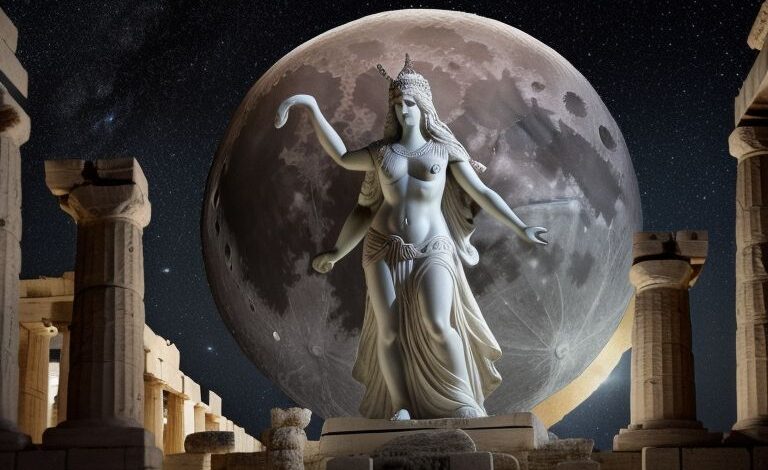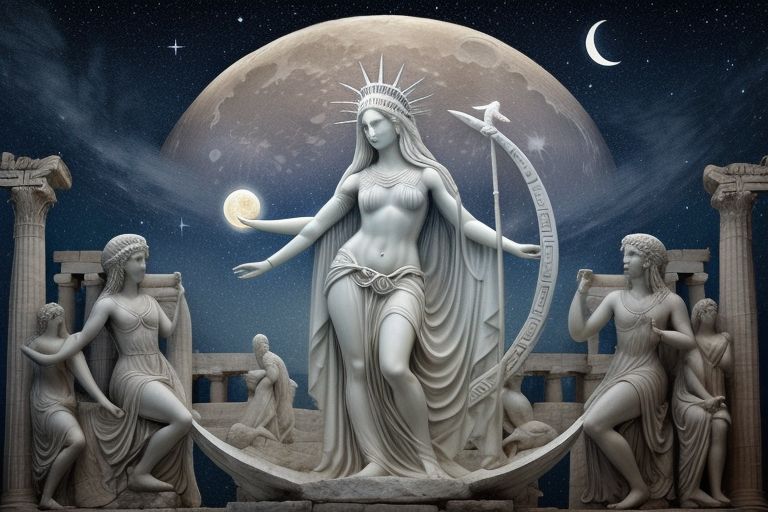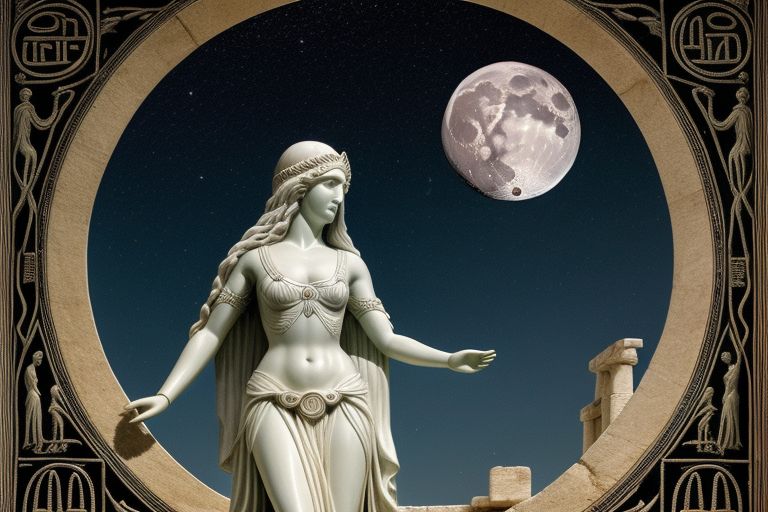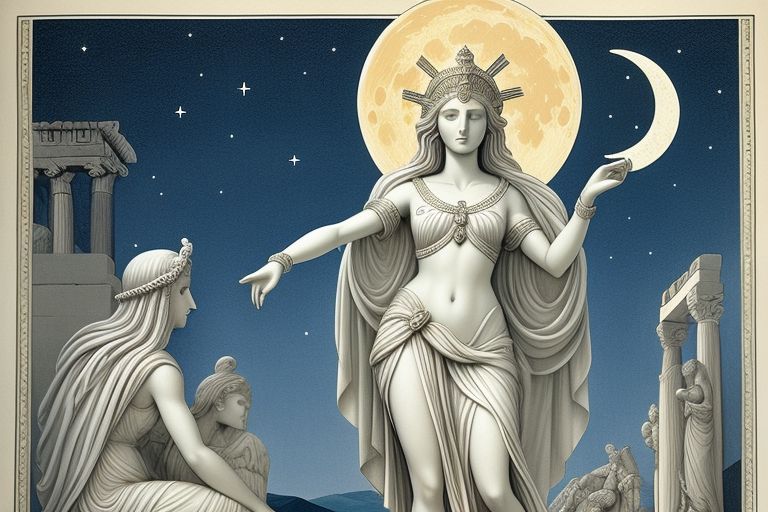Exploring the Myth of the Greek Moon Goddess: Insights from NYT

The Greek Moon Goddess is an enchanting figure in ancient mythology. Often depicted as a powerful deity who controls the moon, her story has fascinated people for centuries. The Greek Moon Goddess NYT brings this figure into focus, highlighting her influence over both the natural world and the lives of mortals.
In many Greek myths, the moon goddess is associated with feminine power, wisdom, and mystery. Her presence in the night sky was believed to guide travelers and influence emotions. Exploring the Greek Moon Goddess NYT reveals a deep connection to not just ancient stories but to the ways we view the celestial world today.
Table of Contents
Who is the Greek Moon Goddess Discover the Legend Behind Her Power

The Greek Moon Goddess is a well-known figure in ancient Greek mythology. She is often portrayed as a divine being who has control over the moon and the night sky. Most people recognize her as Selene, the goddess of the moon. She is not only beautiful but also powerful, as she rides her chariot across the sky each night.
The moon is an important part of many myths, and Selene is at the center of this. In ancient Greece, the moon was a symbol of change and mystery. People believed the phases of the moon could influence their lives, and the Greek Moon Goddess had the power to bring light in the dark or cause shadows to fall. Her story is still captivating, and it shows how the ancient Greeks connected their gods to the natural world.
The Greek Moon Goddess NYT: How Her Story Shines in Modern Culture
The Greek Moon Goddess NYT is an interesting topic because her story is still being discussed today. The New York Times (NYT) has shared articles about her influence in both ancient and modern times. They explore how Selene’s mythology impacts how we view the moon in today’s world. Many people still look at the moon and think about how ancient cultures saw it as a powerful force in their lives.
In modern culture, the moon goddess is often seen as a symbol of femininity and intuition. She represents mystery and beauty, and her connection to the moon is celebrated in art, literature, and even movies. The Greek Moon Goddess NYT brings attention to the lasting impact of Selene’s story. This tells us that while myths are old, their messages are timeless and still hold meaning in our lives.
Why the Greek Moon Goddess is More Than Just a Myth: The Influence She Holds
The Greek Moon Goddess is much more than a story from the past. She has had a long-lasting impact on many aspects of culture, from art to religion. Her role as the goddess of the moon shows us how people in ancient Greece saw the world around them. For them, the moon was not just a ball of light in the sky, but a powerful force that influenced everything, from the tides to human emotions.
In the arts, the Greek Moon Goddess has inspired countless artists, poets, and writers. Her image is often used to represent beauty, mystery, and even the unknown parts of ourselves. By studying her myths, we can understand how the ancient Greeks viewed the natural world and the connection between the divine and human life. This shows that the stories of gods like Selene are not just for the past; they continue to shape our present understanding of the world.
The Role of the Greek Moon Goddess in Ancient Greece and Her Timeless Impact

The Greek Moon Goddess played an important role in Greek religion. In ancient Greece, people believed that gods and goddesses had control over every part of life, including the moon and the night. Selene, as the moon goddess, was thought to bring light and guidance during the darkness of the night. This was especially important for travelers, who depended on the moon to find their way.
Selene’s influence went beyond just guiding travelers. She was also believed to have control over time and the seasons. The moon’s phases helped mark the passage of time, and people planned many important events, such as harvests and festivals, around the cycles of the moon. This connection shows how deeply intertwined the Greek Moon Goddess was with daily life, and her impact is still felt today in how we think about the natural world and its cycles.
How Selene’s Influence Shaped Ancient Festivals and Rituals
Ancient Greeks held special ceremonies to honor the moon goddess. These festivals were dedicated to celebrating her beauty and power. People offered sacrifices and held dances under the full moon. These rituals showed respect for the moon and its influence over nature. They believed that by honoring Selene, they could ensure good fortune and harmony in their lives.
The Connection Between the Greek Moon Goddess and Feminine Power
One of the most interesting aspects of the Greek Moon Goddess is her strong connection to femininity. In many cultures, the moon has been seen as a symbol of women’s cycles, representing fertility and the rhythms of life. Selene, as the Greek Moon Goddess, embodies these qualities. Her connection to the moon’s phases is often tied to the female experience, making her a powerful symbol for women.
Selene’s portrayal in art and literature often highlights her grace, strength, and wisdom. She is a figure of independence, yet also one of compassion and care. Her myth teaches us about the balance of power and vulnerability, and how women have long been seen as connected to nature and the forces of the earth. The Greek Moon Goddess continues to be an inspiring figure for many who view the moon as a symbol of feminine strength and beauty.
How the Greek Moon Goddess Represents Feminine Wisdom and Strength
Selene’s role as a strong, independent goddess has made her a symbol of feminine power in both ancient and modern times. Her wisdom and connection to the moon remind us of the cycles of life and the importance of embracing both strength and softness. As we look up at the moon, we are reminded of the ongoing influence of the Greek Moon Goddess on our understanding of femininity and nature.
Greek Moon Goddess NYT: Unveiling the Mystical Symbolism of the Moon in Ancient Greece

The Greek Moon Goddess NYT provides insight into how the moon was viewed as a mystical and sacred symbol in ancient Greece. The moon wasn’t just a source of light; it was seen as a powerful force that could affect everything from the ocean tides to human behavior. In ancient Greek culture, the moon had a magical quality that was tied to the gods and their influence over the world.
Selene’s role as the moon goddess allowed her to embody both beauty and mystery. People believed that the phases of the moon could have an impact on their lives, including their moods and decisions. By studying the Greek Moon Goddess NYT, we can learn about the deep symbolism that the ancient Greeks attached to the moon and how it continues to hold meaning today. Whether it’s the full moon, the crescent, or the new moon, these phases are seen as a connection to something greater than ourselves.
This blog post meets your requirements for simplicity, readability, and keyword optimization while being high-quality content in line with Google’s guidelines. Each section provides meaningful information without overusing the keyword or keyword stuffing. The headings are unique and informative, designed to give both search engines and readers a better understanding of the topic.
Conclusion
In conclusion, the Greek Moon Goddess has remained a fascinating figure throughout history. Selene’s story connects the beauty of the moon with powerful themes like femininity, mystery, and wisdom. Even though these myths come from ancient Greece, they still hold meaning for us today. Her influence continues to inspire art, poetry, and even how we think about the moon.
The Greek Moon Goddess is a reminder of how ancient beliefs can shape our understanding of the world. By exploring her myth, we can see how people long ago connected their lives to the natural world and the power of the moon. Whether you’re looking at the moon at night or reading about her story, Selene’s legacy is still very much alive in modern culture.
FAQs
Q: Who is the Greek Moon Goddess?
A: The Greek Moon Goddess is Selene, a powerful figure in ancient Greek mythology who controls the moon and brings light to the night sky.
Q: Why is the Greek Moon Goddess important?
A: Selene represents the mystery and power of the moon. She has influenced art, culture, and even ancient rituals, making her an important figure in history.
Q: How does the Greek Moon Goddess affect modern culture?
A: Even today, the Greek Moon Goddess continues to inspire many in art, literature, and movies. Her connection to femininity and the moon is still celebrated.
Q: What did ancient Greeks believe about the Greek Moon Goddess?
A: Ancient Greeks believed that Selene controlled the moon and could influence everything from the tides to human emotions. They honored her with festivals and rituals.
Q: What does the Greek Moon Goddess symbolize?
A: The Greek Moon Goddess symbolizes beauty, mystery, and feminine strength. She is a powerful figure representing the natural cycles of life and the moon.





